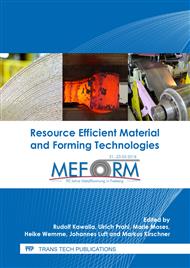p.103
p.110
p.117
p.125
p.134
p.140
p.145
p.152
p.159
Effect of Cooling and Isothermal Holding on the Amount of Martensite/Austenite (M/A) Constituents, Microstructure and Mechanical Properties of Microalloyed Pipeline Steel
Abstract:
Constant increase of energy consumption in modern industry requires construction of heavily loaded pipelines with high throughput capacity. Therefore, high-strength steels should be used for the cost reasons. Additionally, the pipelines are also often used in the areas with cold climate and high seismicity. Therefore, strength and plasticity reduction is unacceptable. Bainitic steels with retained austenite (RA) or martensite/austenite (M/A) constituents meet these requirements. The purpose of this investigation is to determine thermo-mechanical treatment parameters with further accelerated cooling and additional isothermal holding for M/A-phase and mechanical properties formation. Experimental modeling of the production process was carried out using Gleeble HDS-V40 thermo-mechanical simulator. All investigations were realized with two high-strength micro-alloyed steels with different molybdenum and carbon content. Results showed that decrease of temperature and duration of isothermal holding as well as addition of molybdenum promote bainitic microstructure nucleation and reduce grain size and M/A-constituents. All these factors lead to a slight improvement in mechanical properties.
Info:
Periodical:
Pages:
152-158
Citation:
Online since:
March 2018
Authors:
Permissions:
Share:
Citation:


